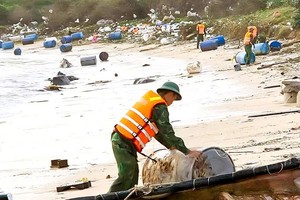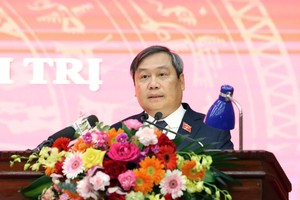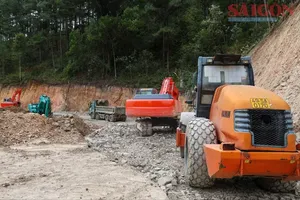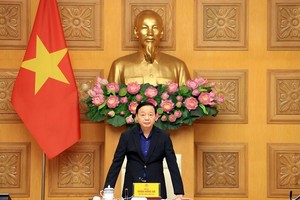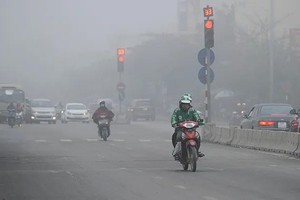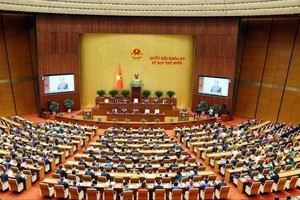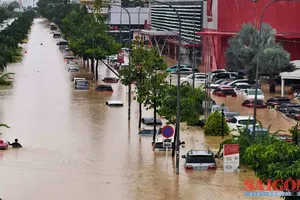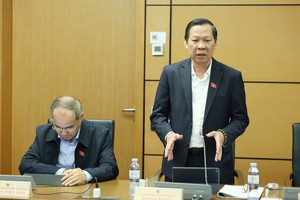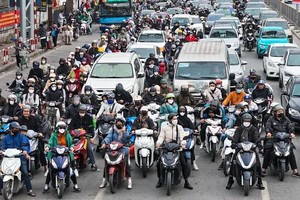 |
Electricity workers in Hanoi are urging people to conserve electricity due to power shortages during the summer of 2023. |
While renewable energy sources are currently in surplus, the national power system in 2023 is at risk of experiencing electricity shortages due to extreme weather conditions and a growing number of hydropower plants reaching dangerously low water levels. Why is this situation occurring?
Continuous power cuts
Luong Van Thien, a resident of Him Lam Nam Sai Gon apartment complex in Hamlet 4, Binh Hung Commune, Binh Chanh District, Ho Chi Minh City, reported that in mid-May 2023, Binh Chanh Power Company sent a notification to his family. The notice stated that due to power grid maintenance, there would be temporary electricity disruptions from 8 a.m. to 2 p.m. on May 18. On May 21, the company issued another announcement, explaining that a power grid malfunction would result in temporary electricity interruptions from 12:03 p.m. to 2:03 p.m. on the same day. Thien expressed his frustration, stating that during the scorching summer, they experienced power outages twice during lunchtime within a week. The apartment complex accommodates thousands of residents, half of whom are children.
On May 17, the entire Phu An Thanh Industrial Park in Ben Luc District, Long An Province suffered a power outage. In the most recent update, Ben Luc Power Company notified one of its customers, Phu An Thanh Company, about a planned electricity interruption from 7 a.m. to 5 p.m. on May 27.
Toan Phat Radiation Company in Phu An Thanh Industrial Park specializes in irradiating dragon fruits and seafood before export. The frequent power cuts in May 2023 have significantly affected the company's production and business operations. Since the beginning of May 2023, the company has had to spend an additional cost of approximately VND50 million on diesel fuel to operate the power generator.
Mr. Nguyen Vinh Huy, Vice Chairman of the HCMC Union of Business Association, revealed that over the past week, several businesses operating within industrial parks in HCMC had been informed about scheduled power outages occurring between 8 a.m. and 2 p.m. In the event of a power cut, these factories are required to activate their backup power generator systems to ensure the operation of their cold storage facilities.
Renewable energy in excess
Electricity shortages and alternating power cuts are not limited to the Southern region but are also happening in the Northern and Central regions during recent hot and sunny days. The primary reason behind this is a severe water shortage in hydropower plants.
On May 22, Mr. Tran Dinh Nhan, the CEO of Vietnam Electricity Group (EVN), provided an update stating that currently, 18 out of 47 major hydropower reservoirs in the North, Central, Central Highlands, and Southeast regions have reached critically low water levels, while 20 out of 47 water reservoirs have a remaining capacity of less than 20 percent. EVN's leadership explains that over the past few months, the water levels in the rivers feeding into these reservoirs have been the lowest in the past 100 years. Mr. Nhan confirmed that as of May 21, the remaining electricity production in the water reservoirs was only about 29 billion kWh, 1.7 billion kWh lower than the annual plan.
Meanwhile, due to the hot weather, there has been a substantial increase in electricity consumption nationwide. Mr. Nhan stated that on May 19, electricity consumption reached a record high of 924 million kWh, with a peak capacity of 44.6 GW - the highest ever recorded. "We are consistently operating without any backup reserves. To ensure system stability and safety, EVN has had to utilize all available power sources, including costly options such as diesel and fuel oil," shared Mr. Nhan.
The question raised by the public is: Why is there a power shortage when renewable energy sources are in surplus while many completed power plants are unable to generate electricity for the grid? According to statistics, there are currently 85 renewable energy power plants in the transition list that have not yet been able to operate commercially. In an interview with a reporter from SGGP Newspaper on the afternoon of May 22, Mr. Vo Quang Lam, Deputy General Director of EVN, provided information that renewable energy currently accounts for approximately 27 percent of the installed capacity and contributes around 13 percent of the electricity output compared to the total installed capacity of the entire system. Therefore, the generated output from renewable energy sources is still relatively insignificant compared to other forms, such as hydropower and thermal power.
Mr. Lam explains that renewable energy sources have inherent unpredictability and low reliability due to their intermittent power generation. For instance, solar power is only abundant during midday but cannot be stored for peak hours, leading to potential shortages. Similarly, wind power is strongest during December, January, and February, with considerable fluctuations throughout the day. Therefore, despite the surplus of wind and solar power, Vietnam still faces the risk of electricity shortages. To ensure power system stability, reliance on hydropower and thermal power remains necessary.
In the current context of severe power shortages, Mr. Lam emphasizes that EVN will mobilize all available renewable energy sources to be ready for grid connection and reduce the load during the projected period of high electricity demand in the coming months.
As of May 21, the Ministry of Industry and Trade has approved provisional electricity selling prices for 15 out of 37 transitional renewable energy projects with a capacity of 1,200 MW, and these projects are in the final stages of document completion to prepare for grid integration. Mr. Lam also mentioned that due to the hot weather, the electricity demand is expected to continue surpassing previous records. "EVN will operate the power system more flexibly, closely following the actual electricity usage and weather patterns. We will divide and specify operation plans and source regulation," Mr. Lam stated.
Quang Ninh: Two localities to import electricity from China
On May 22, in Dongxing City, Guangxi Province, China, a delegation from the Northern Power Corporation held a meeting with the Guangxi Power Grid Company to negotiate a power purchase agreement between EVN and the Guangxi Power Grid Company.
During May, June, and July, the electricity obtained from China will be supplied to the Mong Cai 110kV substation in Mong Cai City and the Quang Ha 110kV substation in Hai Ha District, Quang Ninh Province. The signing of the power purchase agreement between both parties is expected to take place on May 23, and the official power transmission from Shekou (China) to Vietnam through the Shekou - Mong Cai 110kV transmission line will commence at midnight on May 24.
On the same afternoon, the Ministry of Industry and Trade held a conference to launch the National Electricity Saving Campaign for 2023. The objective of the campaign is to provide updates on the electricity supply situation and promote a nationwide movement for electricity conservation.



